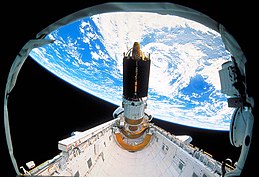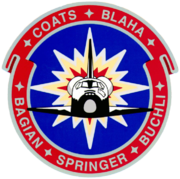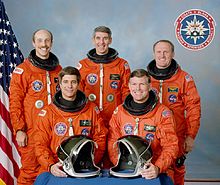 TDRS-D being deployed on Flight Day 1 of the mission. | |
| Names | Space Transportation System-29 STS-29R |
|---|---|
| Mission type | TDRS-D deployment |
| Operator | NASA |
| COSPAR ID | 1989-021A |
| SATCAT no. | 19882 |
| Mission duration | 4 days, 23 hours, 38 minutes, 50 seconds |
| Distance travelled | 3,200,000 km (2,000,000 mi) |
| Orbits completed | 80 |
| Spacecraft properties | |
| Spacecraft | Space Shuttle Discovery |
| Launch mass | 116,281 kg (256,356 lb) |
| Landing mass | 88,353 kg (194,785 lb) |
| Payload mass | 17,280 kg (38,100 lb) |
| Crew | |
| Crew size | 5 |
| Members | |
| Start of mission | |
| Launch date | March 13, 1989, 14:57:00 UTC (9:57 am EST) |
| Launch site | Kennedy, LC-39B |
| Contractor | Rockwell International |
| End of mission | |
| Landing date | March 18, 1989, 14:35:50 UTC (6:35:50 am PST) |
| Landing site | Edwards, Runway 22 |
| Orbital parameters | |
| Reference system | Geocentric orbit |
| Regime | Low Earth orbit |
| Perigee altitude | 297 km (185 mi) |
| Apogee altitude | 308 km (191 mi) |
| Inclination | 28.45° |
| Period | 90.60 minutes |
| Instruments | |
| |
 STS-29 mission patch  Back row: Bagian, Springer and Buchli Front row: Blaha and Coats | |
STS-29 was the 28th NASA Space Shuttle mission, during which Space Shuttle Discovery inserted a Tracking and Data Relay Satellite (TDRS) into Earth orbit.[1] It was the third shuttle mission following the Challenger disaster in 1986, and launched from Kennedy Space Center, Florida, on March 13, 1989.[2] STS-29R was the eighth flight of Discovery and the 28th Space Shuttle mission overall; its planned predecessor, STS-28, was delayed until August 1989.
The mission was technically designated STS-29R as the original STS-29 designator belonged to STS-61-A, the 22nd Space Shuttle mission. Official documentation and paperwork for that mission contained the designator STS-29 when it was allocated to Space Shuttle Columbia and later as STS-30 when allocated to Challenger. As STS-51-L was designated STS-33, future flights with the STS-26 through STS-33 designators would require the R in their documentation to avoid conflicts in tracking data from one mission to another.
- ^ "STS-29 Press Kit" (PDF). NASA. March 1989. Archived (PDF) from the original on January 6, 2021.
 This article incorporates text from this source, which is in the public domain.
This article incorporates text from this source, which is in the public domain.
- ^ Dye, Lee (March 14, 1989). "Space Shuttle Launched, Puts Satellite in Orbit". Los Angeles Times. Archived from the original on January 6, 2021.